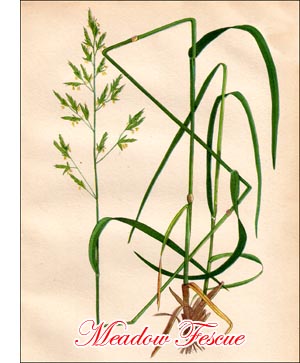Meadow Fescue Grass
 Festuca elatior L.
Festuca elatior L.The most common of the genus is the Meadow Fescue, which was introduced from Europe many years ago.
For so tall a grass the smooth stems are quite slender, and with their tapering, shining leaves are a wide contrast to Timothy, which begins to bloom before the Meadow Fescue has faded, and is so often associated with it in the fields.
The long spikelets of Meadow Fescue are green, frequently tinged with reddish purple, and in bloom the flowers for a short time are broadly open, giving delicacy to the one-sided, drooping panicle, which after flowering is narrow and closely contracted.
Meadow Fescue. Tall Fescue. Festuca elatior L.
Perennial. Naturalized from Europe.
Stem 2-5 ft. tall, erect. Ligule very short. Leaves 3'-15' long, 2"-4" wide, flat, often rough.
Panicle 4'-12' long, narrow, usually nodding at top, branchesspreading in flower, erect before and after blossoming. Spikelets 4-9-flowered, 4"-6" long, green or tinged with purple. Outer scales acute, unequal; flowering scales acute or short-pointed; palets nearly as long as flower-scales. Stamens 3, anthers reddish purple or yellow.
Meadows, fields, and waysides. June to August.
Nova Scotia to Ontario and southward.
Meadow Fescue picture
Meadow Fescue seed